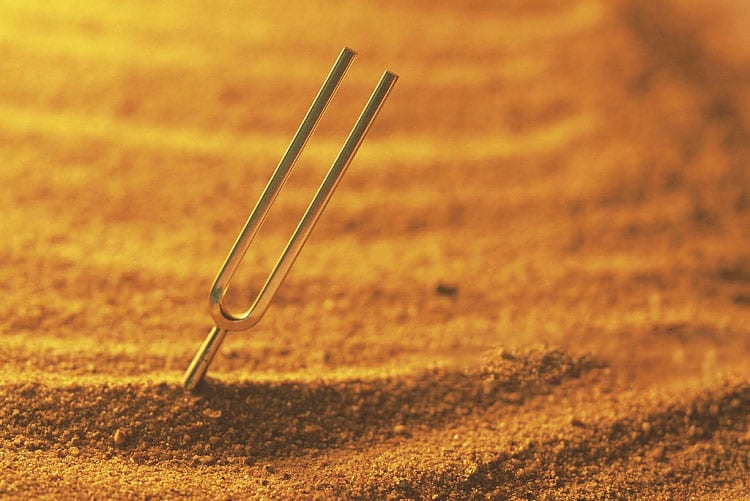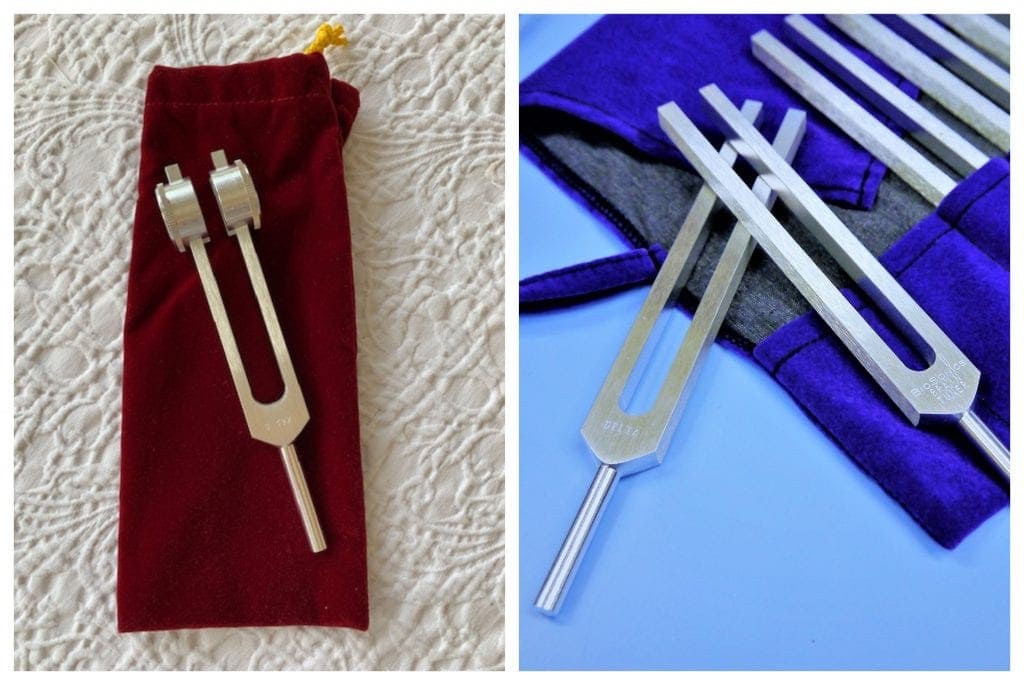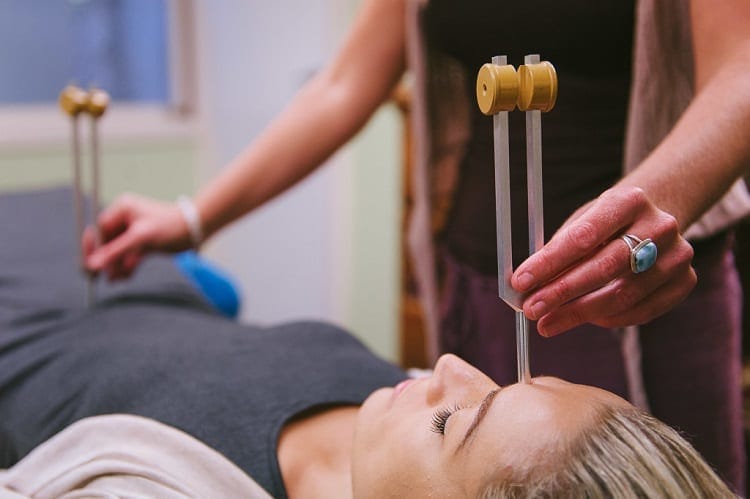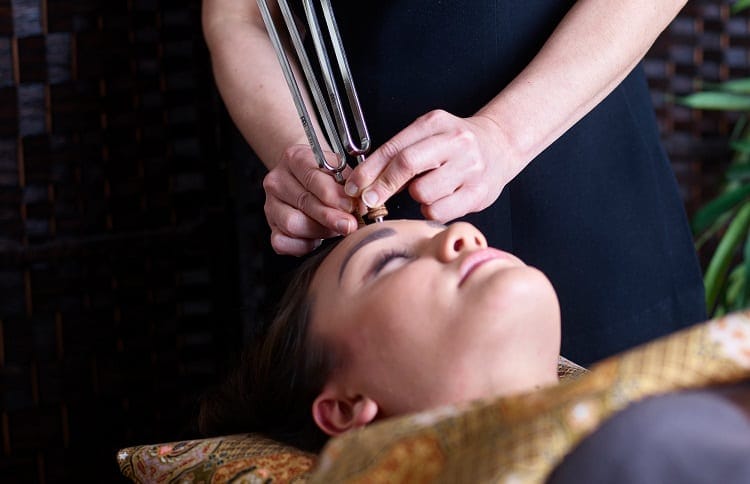You’ve probably heard of tuning forks.
They’re calibrated metal forks with two prongs that are used to tune musical instruments.
But that’s not all they’re known for: tuning forks are also used in alternative healing.
What is tuning fork therapy?
This is the use of sound and vibration to balance the body’s energy. It reduces tension and promotes emotional harmony, and works in a similar way to acupuncture. Instead of needles, sound frequencies are used to stimulate points in the body.
Tuning fork therapy makes use of vibrational frequency that increases energy flow in the body, which improves circulation and removes blocked energy in the body. This results in many benefits.
Tuning Fork Therapy Benefits

There are many health benefits of using a tuning fork. These include:
- It stimulates the cells to produce nitric oxide. When sound frequencies do this, it benefits the body by enlarging the blood vessels. This means that it increases blood flow. In addition, it enables cells of the body to work better, which also has a positive effect on blood pressure.
- By calming you down, inflammation in the body is lowered, as Shape reports. In addition, vibrations can lower heart rate and brain wave patterns, thus helping you to relax.
- This, in turn, can provide an alternative treatment for conditions such as anxiety, post-traumatic stress disorder (PTSD), and sleep disorders.
- Sound therapy can also help to relieve pain. Some studies have suggested that tuning forks, in particular, can relieve bone and muscle pain, as reported by Senses & Sciences.
The Types Of Tuning Forks

There are two types of tuning forks. These are weighted and unweighted forks.
Weighted Tuning Forks
These are tuning forks that have weights at the end of each prong. These are used on the body to relieve pain, such as inflammatory pain from health conditions like arthritis.
You can use them directly in the area of the body that you want to treat. They generate stronger and deeper vibrations than unweighted forks, although they tend to be more expensive.
Unweighted Tuning Forks
These tuning forks don’t have weights attached to them and they’re commonly used around the body and ears to balance the body’s energy, instead of being placed directly on the body.
These tuning forks are usually used for physical, emotional, spiritual, and mental awareness.
It’s good to bear in mind that unweighted tuning forks are subtler when compared to weighted forks. This can make them a bit less effective if you want to relax tight, sore muscles.
Instead, turn to them when you feel you need to balance your emotional and mental energy, or if you want to encourage greater relaxation and harmony.
History Of Tuning Forks

Tuning forks are part of what’s known as sound therapy.
This is an ancient cultural practice that makes use of singing bowls and chants to relieve pain. But let’s take a look at their history and how they came about.
Tuning forks were actually invented in 1711 by a man called John Shore who was a trumpeter and lutenist. The tuning fork soon became a musical instrument that was played in church and concert halls throughout Europe.
It’s quite amazing to think that initially, the tuning fork was just a small instrument made of steel with two flat prongs.
These vibrated and produced a musical note that was of a constant pitch. The fork was used to tune musical instruments, as the Journal of Neurology, Neurosurgery and Psychiatry reports.
It was only in the 20th century that tuning forks were applied to muscles and bones to create a vibration which was seen as a way to test neural pathways in the body.
An English osteopath called Sir Peter Guy Manners is said to be the father of sound therapy from which tuning fork therapy came about.
In the 1960s, Manners concentrated his work on the use of sound frequencies that were being used in the treatment of various diseases.
As pointed out by the Senses & Sciences journal, Manners realized that sound therapy stimulated the human body’s ability to heal itself.
The Science Behind Tuning Forks

So, how do tuning forks actually work?
This non-invasive healing is actually quite scientific.
How it works is that the tuning fork will be struck and held by its base or stem at a certain point over the skin, such as a chakra or acupuncture point.
Simultaneously, a tone is produced. By slowly moving the tuning fork over the person’s aura or space around them, it can offer healing properties.
Tuning forks are made in such a way that they generate a pure sound, with a specific amount of vibrations every second.
But sound therapy is also about targeting your brainwave frequencies and the vestibulocochlear nerve in the ear.
As Shape reports, this nerve connects to the vagus nerve, which is the major parasympathetic nerve in the body and it regulates your digestion as well as your rest, so it’ll lower your blood pressure and relax your muscles, while also controlling your blood glucose levels and the body’s release of hormones.
The vagus nerves go to the tympanic membrane, located in the ear, and it vibrates when it identifies sound waves.
When sound is processed by the ears, this reaches the vagus nerve.
By stimulating the vagus nerve with the right sound frequencies, this can help you heal in a variety of ways.
How Is A Tuning Fork’s Sound Actually Created?
A tuning fork creates vibrations that interact with the air surrounding it.
As the fork’s prongs move away from each other, they push air molecules together, creating small compressions.
When the prongs move back together, they pull the air molecules and form low-pressure areas called rarefactions. The compressions and rarefactions create sound.
How To Use A Tuning Fork
You don’t always have to go to a professional or alternative practitioner to be treated with tuning forks.
You can purchase your own and use them on yourself. However, there are some important tips for using a tuning fork that you should bear in mind.
- You should start by producing a sound in the tuning fork. You could use a rubber mallet to strike it or gently tap the tuning fork against your knee or the palm of your hand. In fact, it’s said that striking an unweighted tuning fork against a rubber mallet is best while tapping a weighted tuning fork against the palm of your hand is enough.
- To ensure you get the best sound from an unweighted tuning fork, you should always strike the tuning fork’s prong one-third of the way from the top of the tuning fork. If you have a weighted tuning fork you should hit it on the top of the weighted portion.
- Avoid striking any tuning fork on a hard surface as this can damage it. Although it’s usually made of elastic steel, it’s still a delicate instrument. You should also avoid tapping two tuning forks against each other as this can also damage them.
- Hold the tuning fork by its handle or stem, but keep your wrists flexible and relax your fingers.
- Prevent tension in your arm by bending your elbow while holding the tuning fork. This is important because you don’t want that tension to move to your hand and result in discomfort while using the tuning fork.
- Make sure you hold the tuning fork on its side. This enables you to strike only one of its prongs. Its U-shape enables both of its prongs to vibrate and create a smoother, purer sound.
- If you are using an unweighted tuning fork, you should bring it close to the area of your body (such as an area that’s experiencing pain) without actually making contact with your skin. Slowly sweep the tuning fork over the area. You can also bring the tuning fork up to your ear, keeping it about two inches away from your ear, and hold it there while it rings out its sound and vibrates. Based on what we mentioned earlier about the ear and vagus nerve, this can be highly beneficial to the nervous system.
- If you are using a weighted tuning fork, you can use it directly on the area of the body that’s experiencing pain or discomfort, such as a muscle or joint. Gently touch the part of the body with the fork and you’ll be able to feel the vibration.
How To Use Tuning Forks For Chakras

First, what are the chakras?
The seven chakras of the body are circular vortexes of energy that are found in seven points along the spinal column.
All the seven chakras are linked to various glands and organs in the body.
To enable chakra healing with the use of tuning forks, it’s good to know what each of the seven chakras requires when it comes to healing sound.
The frequencies are measured in hertz (Hz). As the Pure Integrated Health Services Foundation reports, here are the frequencies commonly used to stimulate the different chakras:
- 1st chakra makes use of 396 Hz and it helps to release fear and guilt.
- 2nd chakra makes use of 417 Hz and it enables change.
- 3rd chakra makes use of 528 Hz and it enables transformation.
- 4th chakra makes use of 639 Hz and it helps one connect to others.
- 5th chakra makes use of 741 Hz and it encourages expression and solutions to problems.
- 6th chakra makes use of 852 Hz and it encourages the intuition to be awakened.
- 7th chakra makes use of the previous six frequencies as it connects one to the universe.
When your chakras are to be stimulated by tuning forks, you can expect to be asked to lie down on a massage table.
The practitioner will hold the tuning fork over the chakra (or all of them, one at a time) to create greater harmony in the body.
He or she will create an energy bridge from one chakra to the next, and two forks are usually used to track the energy channels all the way up the base of the spine.
Sound therapy is said to restore the chakra balance and help the energy to move better throughout the body.
Other Interesting Uses For Tuning Forks

It’s not just sound therapy that makes the tuning fork useful.
These instruments can be used in the medical world in other ways, such as to diagnose hearing loss.
Some audiologists still prefer to use tuning forks to diagnose hearing problems, as How Stuff Works reports.
They make use of a test known as the Rinne test.
During this test, the doctor will hold a tuning fork that’s making a humming sound to the patient’s head and then use a watch to see how long the patient is able to hear the sound.
Then, the tuning fork will be struck again and held close to the patient’s ear.
Interestingly, the site goes on to explain that if the patient can hear the sound made by the tuning fork through their jaw longer than when it’s near their ear, they might have a problem when it comes to conducting sound waves via the ear canal.
Another test for hearing problems is the Weber test. In this test, the doctor will hold a vibrating tuning fork in the middle of the person’s forehead.
The doctor will ask the patient which one of their ears can hear the loudest sound produced by the fork.
If one ear can hear better than the other, then this tells the doctor which ear has a problem.
What Are Tuning Fork Facials?

Tuning forks are becoming so popular as an alternative treatment that they are even being used in tuning fork facials.
During this skincare and beauty treatment, tuning forks vibrate to rejuvenate the skin, mind, and spirit, but it’s best to consult with a professional instead of trying this yourself.
As Coveteur reports, it’s said that the vibrations can relax muscles, help one to relax, and also boost the body’s lymphatic drainage.
Various areas of the face can be targeted, such as the chin and jowls.
The vibrations caused by the tuning forks can help to relax the muscles in the face, which is especially beneficial for people who carry tension and stress in their facial muscles because this treatment can be like a relaxing massage.
Steel Vs. Aluminum Tuning Forks
Although it’s common for tuning forks to be made out of steel, there are also aluminum forks available.
What are the differences between these two materials? Is one better than the other?
It’s been said that aluminum tuning forks have the potential to ring overtones, and this is a good thing because overtones refer to hidden sounds in music.
Overtones are important in sound healing because they stimulate the “neural net through tactile stimulation and auditory nerve conduction,” as Dr. John Beaulieu, philosopher, and innovator in sound healing therapy, says in an article published on Omnivos Therapeutics.
These overtones produce many pulsations that have a massage-like effect on the listener.
Their sound waves move through the brain and create many different structural and physiological events in the body.
Of course, steel tuning forks also have their benefits. They are tuned when you tap them on the palm of your hand or against your knee.
They have the same effect as forks that are made out of aluminum, and will also bring balance to the nervous system.
That said, they don’t ring overtones as aluminum tuning forks do. That’s the biggest difference, and, as explained above, is important.
Related Questions
What’s the most common sound that a tuning fork produces?
It’s the note of A = 440 Hz, which is the concert pitch used by many orchestras.
The A sound is specifically the pitch of the violin’s second string, and it’s an octave higher than the first string of the cello.
Why do tuning forks have two prongs and a stem?
The stem is meant to be held so that you don’t disturb the vibration of the fork’s prongs.
If it were just one piece, you’d hold it and this would reduce the sound and vibration created by the tuning fork.
Conclusion
Tuning forks are an example of sound therapy that can be highly beneficial.
Various studies have pointed to the benefits of using them.
This article has outlined some of those benefits and provided a bit of history of the tuning fork, while also explaining how they can be used.
Tuning forks have an interesting history but they are even more relevant today, thanks to their use as an alternative therapy.
They’re growing in popularity, even being used in skincare and pain-relief treatments.

